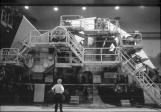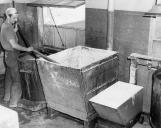40
Last rolls from #1 winder10 September 1962
Powell River, British Columbia, Canada
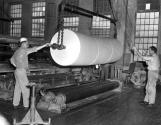 Credits:
Credits:P03406
Catalyst Paper, Powell River Division
41
After nearly 50 years of continual service, the final roll from the final reel produced on Number 1 paper machine is on its way to the finishing room.42
Last roll10 September 1962
Powell River, British Columbia, Canada
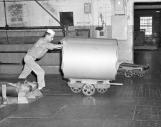 Credits:
Credits:P00663
Dunstan Studios-Powell River Studio
43
1964: Number 10 Paper Machine.The Company announced a huge expansion including a 324-inch paper machine with 52 driers, which would dwarf the giant No. 9 beside it. On June 27, 1967 after months of meticulous training for the crews, and with amazingly few complications, "The Monster" began making newsprint.
Made by Beloit International of Canada Ltd. in Sorel, Quebec, the Machine, Powell River's No. 10 was the largest in the world. It was designed to run at 3,000 feet per minute and was equipped with a data recording system that could be linked to computer. Number 10's 160,000 tons annual output boosted the Powell River mill's yearly newsprint output to 692,000 tons, keeping it in first place as the world's largest single-unit producer. It increased MacMillan, Bloedel and Powell River Company's production to over a million tons a year. In March 1973 No. 10 was operated at 3,000 feet per minute and 300 inch trim continuously for 48 hours, setting a Canadian record.
Bill Thompson,
The Powell River Mill Story
44
Number 10 Paper Machine and WinderCirca 1965
Powell River, British Columbia, Canada
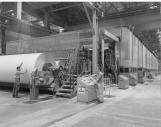 Credits:
Credits:FC114
45
It was designed to run at 3,000 feet per minute and was equipped with a data recording system that could be linked to computer. Number 10's 160,000 tons annual output boosted the Powell River mill's yearly newsprint output to 692,000 tons, keeping it in first place as the world's largest single-unit producer. It increased MacMillan, Bloedel and Powell River Company's production to over a million tons a year. In March 1973 No. 10 was operated at 3,000 feet per minute and 300 inch trim continuously for 48 hours, setting a Canadian record.Bill Thompson,
The Powell River Mill Story
46
Paper Machine Computer3 March 1987
Powell River, British Columbia, Canada
 Credits:
Credits:OS065
Al Pauling
47
The new machine is 302 ft (92 m) long, some 60 feet shorter than conventional paper machines that were operating at 3,000 fpm. Designed to run at 3,500-4,000 fpm, No. 11 would have to dry the sheet even faster, but with a shorter drier section. The drier section was interrupted before the final 8-roll segment by a roll breaker calender stack, which began the calendering process before the sheet entered the final drying stage. The new Monster began turning out newsprint at 3,100 feet per minute in April 1981.48
Number 11 Paper Machine Constructioncirca 1985
Powell River, British Columbia, Canada
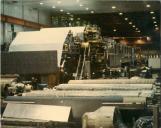 Credits:
Credits:FC028
49
#11- Into the Startup ModeAs far as #11 is concerned, we are presently in the startup mode. In the week of January 19, we started flushing and checking out equipment on the wet end, working toward the dry end. We anticipate getting into the checkout of the machine itself shortly, and flushing the lubrication system.
The whole stock preparation area is broken down into small systems, and we are flushing them one by one. We're looking for any problems with leaks or mechanical problems with pumps. When the problem areas are found, a crew comes right behind and rectifies them. We've been checking the drives for the machines over the past few weeks as well.
The month of February will be hectic. We have to complete the unfinished work, and finish the complete checkout of the systems by mid-march. Approaching fast is stage three of the checkout--when the operators actually have their hands on. This could be ready to occur on some systems by the third week of February.
Powell River Penstock
Vol. 5, No. 1
March, 1981
Historical Note:
By the end of the year, No. 11 was the fastest paper machine in Canada, running at 3,510 feet per minute (a mile of paper every 90 seconds, or 40 miles per hour). In August 1983 it set a world record for one month's production. In 1985 the big machine was rated the best in the world. No. 10 made the world's top ten.
51
Dextrine Glue and Its PreparationBy Hudson Pirie
A lot of you no doubt have seen the big cans of brown, syrupy looking glue we use in the Finishing Room for applying the wrappings on the roll of newsprint. Have you ever stopped to think just how and what glue is made from?
There are many and various kinds, too numerous to mention, but as we use a large amount of what is known as "dextrine" glue, lets see just what kind of stuff it is. The original form of this glue is - believe it or not - corn.
In initial manufacture, the corn, after being mixed with an acid to make it more soluble, is heated to about 235 degrees F., and when dried, is ground into powder form and put into sacks in which form it is received here.
In preparing this type of glue for use, an alkali is usually added along with various ingredients to make the dextrine stickier and faster drying, borax and caustic flakes being used here. The caustic about 3 pounds and borax 35 pounds is mixed in a large steel drum in a small amount of water.
The drum is then filled with water and 200 pounds of dextrine added. Steam is then injected which heats and breaks up the ingredients, while being stirred continuously. This makes up a batch of 660 pounds. After cooling the glue is then ready for use.
Men and Paper
Vol. 1, No. 46
March 29, 1947
53
Core Roll Machine Attracts VisitorsBy Hudson Pirie
After the core stock rolls are manufactured during a wrapper run on one of the paper machines, they are cut up on a rewinder into strips or bands 4 inches wide and about 30 inches in diameter, 12 strips in width per roll.
These rolls are then broken down at the core machine into the individual strips and cleaned, then placed on spools on a rack which holds about 25 of these strips. A standard core will run about 20 of these at one time during the manufacture. The strips are run through a bath of glue and finally met, one on top of the other, on a steel core or shaft coming off in a spiral formation. The strips are kept tight by belts running over the outside bands to insure good adhesion.
The cores come out of the machine into a trough which keeps the core running straight until it reaches a length of 72 ft. when an automatic stop cuts the power and the core is cut off. These cores are piled in a rack holding about 300 finished lengths through which warm air is circulating at all times to ensure thorough drying. The cores are moved every day to make sure the oldest ones are used first. These long cores are cut into the required or programmed length by a "core cutter" using a special ground saw which makes a clean cut, free of ragged edges, which might interfere with the winding.
Men and Paper
Vol. 1, No. 29
November 30, 1946
